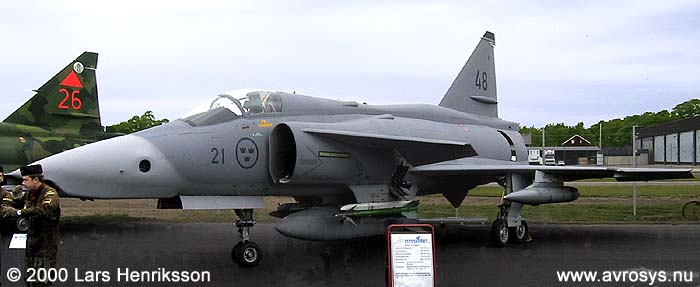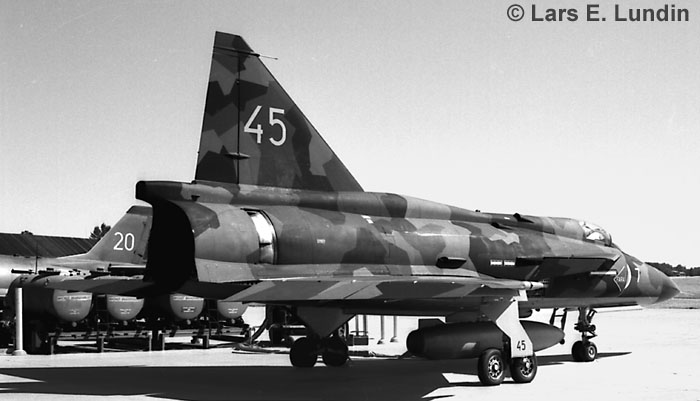|
|
||
|
SF
37/SH 37 Viggen – SAAB SF 37/SH 37 (1975-2007) |
||
| Page 1 (1) | ||
|
|
||
 |
||
|
The System 37, ”Viggen” was developed primarily to succeed the
attack aircraft A 32 Lansen, when its time as a first-line combat
aircraft would be over. Later would also an interceptor- and a
reconnaissance version were to be developed. The Viggen got the at this time
unusual layout with a flapped canard wing and a delta-shaped main wing.
This configuration was used to combine good performance at high speed
with a true STOL (Short-Take-Off-and-Landing) capability. The latter was
necessary due to the base system developed by the Swedish Air Force. To
reduce vulnerability, the aircraft have to able to start and land on
short and narrow runways, often straight lengths of ordinary roads. In
addition to the flaps fitted to the canard wing, the Viggen is equipped
with a thrust-reversible engine and wheel-braking by units with an
anti-skid system. This combination gives a landing run of only 500
meters. The attack- and reconnaissance versions are powered with the Pratt &
Whitney JT8D turbo-fan engine, licence-built by Volvo Flygmotor at
Trollhättan. The Swedish designation is RM 8 (=
”Reaktionsmotor 8”). The JT8D was basically a civil engine, but
re-designed in Sweden for its military super-sonic use. Also the
afterburner was to be designed in Sweden. The engine, in its first
version (RM 8A) had a thrust power of 12.000 kp/117,6 kN (including
reheat). The fighter version JA 37 got the stronger engine RM
8B. Another epoch-making feature was the digital computer system in a time
dominated by analogue technique. The system relieved the pilot from many
supervision tasks. He could instead concentrate himself on pure
operational duties. To get room for this relatively large aircraft in
the Swedish system of rock hangars, the tail was made foldable. In February 1967, the first prototype flew for the first time. Next
year, the Air Force ordered the first batch of the Viggens. 108 aircraft
of the attack version AJ 37 and 18 of the two-seated trainer
version SK 37 were purchased. The designation ”AJ” indicates
that the aircraft secondary also is able to execute interceptor duties.
Viggen was also ordered in two reconnaissance versions, the SF 37
overland reconnaissance aircraft and the SH 37 sea reconnaissance
version. 28 SF 37s and 27 SH 37s were built. Later, the 149 JA 37s were
purchased. The SF 37 (“F” =”Fotospaning” = “Photo
Reconnaissance”) variant has seven cameras installed in the
angular nose, but no radar. Of
these are three of the type SKA 24C (SKA = Seriekamera) with a focal
length of 12 cm. They are used for photo missions at low altitudes and
mounted to give a panorama view from horizon to horizon. Two SKA 31
cameras with 60 cm focal length are used at high altitudes and long
distances. One SKA 24 with 5,7 cm focal length (wide angle) is used for
general views. Finally, an passive IR-camera type VKA 702 (VKA = Värmekamera)
is fitted in the nose. For night missions, a pod - MSK = Mörkerspaningskapsel - with
three SKA 34 cameras of 75
cm focal length can be fitted under the airframe. A pod with photo flash
equipment is used together with the MSK. For self defence, six
air-to-air missiles type RB 24 Sidewinder can be carried. The most important equipment of the SH 37 (“H” = “Havsövervakning”
= “Sea Surveillance”) is the reconnaissance radar. The aircraft
can also be equipped with camera pods for missions in daylight or in
darkness. Generally, one camera pod with a SKA 24D (focal length 60 cm)
is mounted at the hardpoint to the right of the extra fuel tank. At
missions in darkness, one MSK is mounted on the other side. Also the SH 37 can be fitted
with six air-to-air missiles type RB 24 Sidewinder for self defence. Later, a number of SF 37s have been modified to AJSF 37 standard.
This means that the aircraft also can be used for active fighter
missions. This has been possible primarily by better computer capacity.
Also a number of SH 37s have been rebuilt to the AJSH 37 variant
to give a more versatile aircraft. Both air-to-air (RB 24) and air-to
surface missiles - RB 04E
for sea targets, or RB 15F for attack missions - can be fitted on the
hardpoints. The name ”Viggen (Thunderbolt”) alludes to the hammer of the ancient
Scandinavian god Tor. His hammer (Mjölner) was able to send away
thunderbolts that could kill several enemies at the same time… SF 37 – Length 16,50 m. Span: 10,6 m. MTOW: 20,450 kg. Max. speed: MACH 2. SH 37 - Length 16,30 m. Span: 10,6 m. MTOW: 20,450 kg. Max. speed: MACH 2. Photo at top: AJSF 37 # 37950 of Wing F 21 (Luleå) on visit to F 7 (Såtenäs) at airshow, June 2000. Note the camera openings and the Rb 74 Sidewinder. Photo below: SH 37 # 37907 when it belonged to Wing F 7. Later it was transferred to F 13 and got the signal code changed from 45 to 13. |
||
 |
||
|
|
|
|
|
|
||
|
|
||
|
|
Updated 2010-07-25 |
|